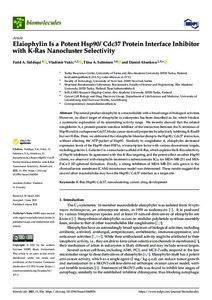Elaiophylin Is a Potent Hsp90/Cdc37 Protein Interface Inhibitor with K-Ras Nanocluster Selectivity
Siddiqui Farid A.; Vukic Vladimir; Salminen Tiina A.; Abankwa Daniel
Elaiophylin Is a Potent Hsp90/Cdc37 Protein Interface Inhibitor with K-Ras Nanocluster Selectivity
Siddiqui Farid A.
Vukic Vladimir
Salminen Tiina A.
Abankwa Daniel
MDPI
Julkaisun pysyvä osoite on:
https://urn.fi/URN:NBN:fi-fe2021093048116
https://urn.fi/URN:NBN:fi-fe2021093048116
Tiivistelmä
The natural product elaiophylin is a macrodiolide with a broad range of biological activities. However, no direct target of elaiophylin in eukaryotes has been described so far, which hinders a systematic explanation of its astonishing activity range. We recently showed that the related conglobatin A, a protein-protein interface inhibitor of the interaction between the N-terminus of Hsp90 and its cochaperone Cdc37, blocks cancer stem cell properties by selectively inhibiting K-Ras4B but not H-Ras. Here, we elaborated that elaiophylin likewise disrupts the Hsp90/ Cdc37 interaction, without affecting the ATP-pocket of Hsp90. Similarly to conglobatin A, elaiophylin decreased expression levels of the Hsp90 client HIF1 alpha, a transcription factor with various downstream targets, including galectin-3. Galectin-3 is a nanocluster scaffold of K-Ras, which explains the K-Ras selectivity of Hsp90 inhibitors. In agreement with this K-Ras targeting and the potent effect on other Hsp90 clients, we observed with elaiophylin treatment a submicromolar IC50 for MDA-MB-231 and MIA-PaCa-2 3D spheroid formation. Finally, a strong inhibition of MDA-MB-231 cells grown in the chorioallantoic membrane (CAM) microtumor model was determined. These results suggest that several other macrodiolides may have the Hsp90/ Cdc37 interface as a target site.
Kokoelmat
- Rinnakkaistallenteet [27094]
